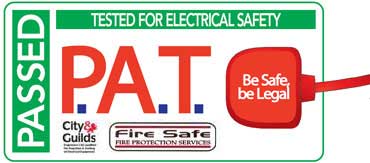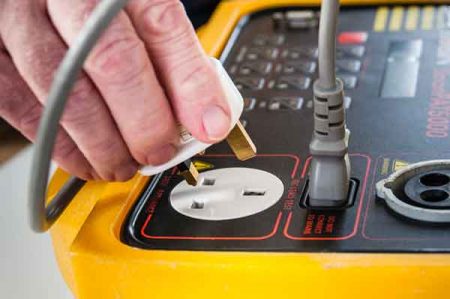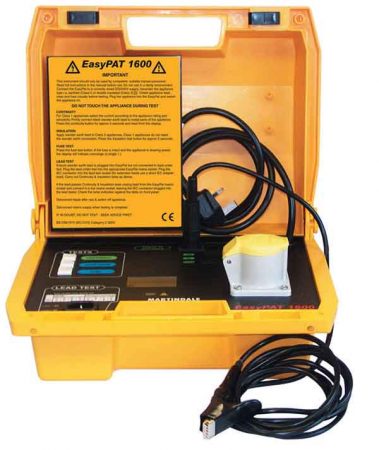Minimum charge: £50.00 (includes up to 14 appliances)

- 15-50 per Appliance: £1.50
- 51-100 per Appliance:£1.20
- 101-500 per Appliance:£0.85
- 501-1000 per Appliance:0.80
- 1000+ per Appliance:£0.75
Each appliance will have a sticker for pass/fail this test lasts for 1 year.
Upon completion, you will be issued a full certificate.
Book Your PAT Test TodayPortable Appliance Testing Glasgow
 It is absolutely essential that workplaces abide by the United Kingdom’s very strict Health & Safety legislation. These laws have been specifically put in place in order to maintain a safe, working environment for each and every employee in the workplace. Furthermore, if the necessary legislation is avoided by a particular institution, and something was the go wrong, then the company can face severe, detrimental penalties as a direct result.
It is absolutely essential that workplaces abide by the United Kingdom’s very strict Health & Safety legislation. These laws have been specifically put in place in order to maintain a safe, working environment for each and every employee in the workplace. Furthermore, if the necessary legislation is avoided by a particular institution, and something was the go wrong, then the company can face severe, detrimental penalties as a direct result.
We are there to make sure that all employers are aware of the steps that they must make in order to abide by the rules. One way to make sure all equipment in the workplace is safe for use by all is by taking part in yearly Portable Appliance Testing in Glasgow. At PAT testing Glasgow we will ensure that all appliances are thoroughly tried and tested for any glitches or damages. What’s more, at our great prices, PAT testing in Glasgow need not be a strain on the wallet. Once the Portable Appliance Testing Glasgow has been undertaken, a sticker will be placed on all confirmed appliances and a full certificate will be issued.
What are the benefits of PAT testing in Glasgow?
This sticker is valid for up to a year, so you know that you and your company are sufficiently covered for a substantial amount of time. Being a part of Portable Appliance Testing in Glasgow will really help to put your mind at ease. To find out what is the cheapest PAT testing Glasgow has to offer, you have come to the right place. We offer a very affordable rate, and there is also the option to order bundle tests, to ensure that all appliances are being checked at once. PAT testing in Glasgow is the only real way to protect yourself and employees, all year round.
So, just remember… if you don’t want to stress off worrying about the safety of your workplace, and also wish to cover yourself for any injuries that may occur in the workplace, Portable Appliance Testing in Glasgow has the answer to all your problems.
Stay Legal. Book your Pat Testing today!
To book your Pat Testing in Glasgow or nearby use the contact form on the contact page or call David on 0141 423 6978 or Mobile 0797 665 3978. Alternatively you could contact DM Electrical by email at info@dm-electrical.co.uk.
LEGISLATION
 If you are a business owner, a landlord, a public service provider or an employer the law requires you to take steps to ensure any electrical equipment you provide is safe to use. Here we’ll summarise the legislation as it currently stands. The legislation of specific relevance to electrical maintenance is:
If you are a business owner, a landlord, a public service provider or an employer the law requires you to take steps to ensure any electrical equipment you provide is safe to use. Here we’ll summarise the legislation as it currently stands. The legislation of specific relevance to electrical maintenance is:
- The Health & Safety at Work Act 1974
- The Management of Health & Safety at Work Regulations 1999
- The Electricity at Work Regulations 1989
- The Workplace (Health, Safety and Welfare) Regulations 1992
- The Provision and Use of Work Equipment Regulations 1998
General legislative guidance
This guidance has been prepared with reference to the Institution of Electrical Engineers Code of Practice for In-Service Inspection and Testing of Electrical Equipment. Although reference is made to legislation, this guide should not be considered as legal advice. In cases of doubt, the specific legislation mentioned should be consulted and legal advice obtained.
In recent years the responsibilities for the safety of persons at work have been prescribed in much legislation. The legislation of specific relevance to electrical maintenance is the Health and Safety at Work Act 1974, the Management of Health and Safety at Work Regulations 1999, the Electricity at Work Regulations 1989, the Workplace (Health, Safety and Welfare) Regulations 1992 and the Provision and Use of Work Equipment Regulations 1998.
The Health and Safety at Work Act 1974 puts a duty of care upon both employer (sections 2, 3 and 4 etc) and employee (section 7) to ensure the safety of all persons using the work premises. This includes the self-employed.
The Management of Health and Safety at Work Regulations 1999 state:
Every employer shall make a suitable and sufficient assessment of the risks to the health and safety of his employees to which they are exposed whilst they are at work, and the risks to the health and safety of persons not in his employment arising out of or in connection with the conduct by him of his undertaking. (Regulation 3(1))
The Provision and Use of Work Equipment Regulations 1998 state:
Every employer shall ensure that work equipment is so constructed or adapted as to be suitable for the purpose for which it is used or provided. (Regulation 4(1))
The Provision and Use of Work Equipment Regulations 1998 (PUWER) cover most risks that can result from using work equipment. With respect to risks from electricity, compliance with the Electricity at Work Regulations 1989 is likely to achieve compliance with PUWER regulations 5-9, 19 and 15.
PUWER only applies to work equipment used by workers at work. This includes all work equipment (fixed, portable or transportable) connected to a source of electrical energy. PUWER does not apply to the fixed installations in a building. The electrical safety of these installations is dealt with only by the Electricity at Work Regulations 1989.
The Electricity at Work Regulations 1989 state:
As may be necessary to prevent danger, all systems shall be maintained so as to prevent, so far as is reasonably practicable, such danger. (Regulation 4(2))
‘System’ means an electrical system in which all the electrical equipment is, or may be, electrically connected to a common source of electrical energy and includes such source and such equipment. (Regulation 2(1))
Electrical equipment includes anything used, intended to be used or installed for use, to generate, provide, transmit, transform, rectify, convert, conduct, distribute, control, store, measure or use electrical energy. (Regulation 2(1))
Scope of the legislation
It is clear that the combination of the Health and Safety at Work Act 1974, the Provision and Use of Work Equipment Regulations 1998 and the Electricity at Work Regulations 1989 apply to all electrical equipment used in, or associated with, places of work. The scope extends from distribution systems, be they 400 kV or simply those in buildings, down to the smallest piece of electrical equipment such as a hairdryer, a VDU, a telephone or even in some situations battery-operated equipment.
Who carries the responsibility in law?
Everyone at work has their responsibilities including, in certain circumstances, trainees. However, because of the all-embracing responsibilities of all persons, this does not minimise the duties of particular persons. Regulation 3 of the Electricity at Work Regulations 1989 recognises a responsibility (control) that employers and many employees have for electrical systems.
It shall be the duty of every employer and self-employed person to comply with the provisions of these Regulations in so far as they relate to matters which are within his control.
It shall be the duty of every employee while at work to co-operate with his employer so far as is necessary to enable any duty placed on that employer by the provisions of these Regulations to be complied with and to comply with the provisions of these Regulations in so far as they relate to matters which are within his control.
The Provision and Use of Work Equipment Regulations 1998 require every employer to ensure that equipment is suitable for the use for which it is provided (Regulation 4(1)) and only used for work for which it is suitable (Regulation 4(3)). They require every employer to ensure equipment is maintained in good order (Regulation 5) and inspected as necessary to ensure it is maintained in a safe condition (Regulation 6).
This legislation applies to normal business, commercial and industrial premises such as shops, offices factories and workplaces. It also applies to residential property let by private landlords.
